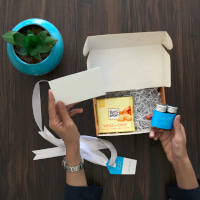How to Ship Chocolate Without Melting
 Whether you run a small homemade chocolate business or simply want to send someone a care package with their favorite chocolates or a delicious Christmas present, you should know how to ship chocolate without melting. Let us offer you a few tips that might come in handy.
Whether you run a small homemade chocolate business or simply want to send someone a care package with their favorite chocolates or a delicious Christmas present, you should know how to ship chocolate without melting. Let us offer you a few tips that might come in handy.
Chocolate melts easily because it contains cocoa butter, which has a melting point of 34 degrees Celsius (93 degrees Fahrenheit). Dark chocolate melts at about the same temperature as cocoa butter, but milk chocolate and white chocolate have a lower melting point due to added dairy ingredients. In general, chocolate melts at 30–32 degrees Celsius (86–90 degrees Fahrenheit) and starts to soften at even lower temperatures (about 21 degrees Celsius, or 70 degrees Fahrenheit).
To make sure your chocolate doesn’t melt while getting to its destination, you need to a) pack it properly and b) choose the fastest shipping method available. And now let’s delve into a more detailed guide on sending chocolate in the mail.
Choose the Right Shipping Service
The sooner your chocolate gets to its intended recipient, the better. Next-day delivery is preferable, especially in summer; two-day delivery may be fine in cooler weather. The fastest shipping service offered by the USPS is Priority Mail Express; it provides next-day to two-day delivery. UPS has UPS Next Day Air for next day delivery and UPS 2nd Day Air for two-day delivery. We recommend mailing your package on Monday or at least in the first half of the week to make sure there are no weekend delays.
Chill the Chocolate Before Shipping (If Possible)
First of all, determine whether your chocolate product can be refrigerated without it affecting its taste and/or texture, or not. If the answer is yes, keep the chocolate in the fridge until it’s time to start packaging. If the chocolate should not be refrigerated, keep at room temperature away from heat sources and direct sunlight.
Choose the Right Packaging Materials
You will need a box for the chocolate, a shipping box, cushioning material to keep the inner box from jostling inside the shipping box (i.e. bubble wrap, protective foam, air cushions, shredded or crumpled craft paper, packing peanuts, etc.), some type of refrigerant to maintain the right temperature inside the package, and strong packing tape.
The shipping box must be at least twice bigger than the box with the chocolate to ensure there is enough room for the coolant and cushioning material that will provide isolation and protect the chocolate from impacts. We recommend to choose a sturdy but lightweight box made from corrugated cardboard.
As for the refrigerant, gel packs are the best choice for keeping your chocolate cold. Gel packs (cold packs) are portable bags filled with refrigerant gel that has a lower freezing point than water. They are affordable, easy to handle, and much safer than dry ice. We recommend that you purchase gel packs that are specifically designed for food packaging. Keep in mind that gel packs need to be frozen before use.
Package Your Chocolate Properly
Start by putting the chocolate inside the smaller box (a Styrofoam container would be a great choice because it provides additional protection and isolation, but a regular cardboard box will to). If you are shipping chocolate candies, make sure they are individually wrapped or separated from one another. For extra protection and insulation, you can wrap the box in a plastic bag.
Line the bottom of the shipping box with cushioning material. Place the container with the chocolate inside the shipping box. Take the gel packs out of the freezer, double wrap them in a plastic bag (to protect the chocolate from condensation), and place them inside the shipping box, surrounding the chocolate. Fill the remaining space inside the shipping box with cushioning material.
Close the box and seal it with strong packing tape. Make sure to cover all seams, corners, and edges of the box—not just to reinforce them but also to improve isolation and reduce the effect of ambient temperature on the contents.
Clearly Label Your Package
In additional to the shipping label with the recipient’s address and tracking barcode, your package will need warning stickers that will let the carrier know that its contents require special handling, such as “Fragile” and “Perishable”.